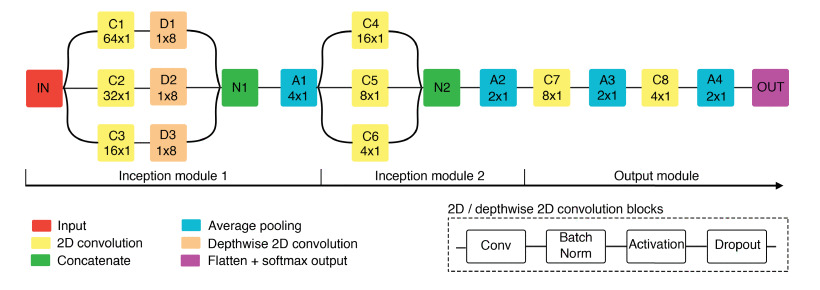braindecode.models.EEGITNet#
- class braindecode.models.EEGITNet(n_outputs=None, n_chans=None, n_times=None, chs_info=None, input_window_seconds=None, sfreq=None, n_filters_time=2, kernel_length=16, pool_kernel=4, tcn_in_channel=14, tcn_kernel_size=4, tcn_padding=3, drop_prob=0.4, tcn_dilatation=1, activation=<class 'torch.nn.modules.activation.ELU'>)[source]#
EEG-ITNet from Salami, et al (2022) [Salami2022]
Convolution Recurrent

EEG-ITNet: An Explainable Inception Temporal Convolutional Network for motor imagery classification from Salami et al. 2022.
See [Salami2022] for details.
Code adapted from abbassalami/eeg-itnet
- Parameters:
drop_prob (float, optional) – Dropout probability.
activation (nn.Module, default=nn.ELU) – Activation function class to apply. Should be a PyTorch activation module class like
nn.ReLUornn.ELU. Default isnn.ELU.kernel_length (int, optional) – Kernel length for inception branches. Determines the temporal receptive field. Default is 16.
pool_kernel (int, optional) – Pooling kernel size for the average pooling layer. Default is 4.
tcn_in_channel (int, optional) – Number of input channels for Temporal Convolutional (TC) blocks. Default is 14.
tcn_kernel_size (int, optional) – Kernel size for the TC blocks. Determines the temporal receptive field. Default is 4.
tcn_padding (int, optional) – Padding size for the TC blocks to maintain the input dimensions. Default is 3.
drop_prob – Dropout probability applied after certain layers to prevent overfitting. Default is 0.4.
tcn_dilatation (int, optional) – Dilation rate for the first TC block. Subsequent blocks will have dilation rates multiplied by powers of 2. Default is 1.
Notes
This implementation is not guaranteed to be correct, has not been checked by original authors, only reimplemented from the paper based on author implementation.
References